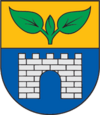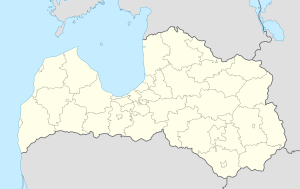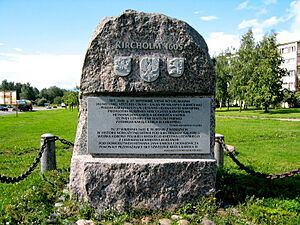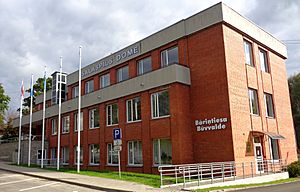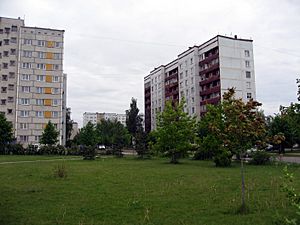Salaspils facts for kids
Quick facts for kids
Salaspils
Kircholm, Kerkolm
|
||
|---|---|---|
|
Town
|
||

Salaspils Railway Station in 2008
|
||
|
||
| Country | ||
| District | Salaspils Municipality | |
| Town rights | 1993 | |
| Area | ||
| • Total | 12 km2 (5 sq mi) | |
| Population | ||
| • Total | 17,621 | |
| • Density | 1,468.4/km2 (3,803/sq mi) | |
| Time zone | UTC+2 (EET) | |
| • Summer (DST) | UTC+3 (EEST) | |
| Postal code |
LV-2121; LV-2169
|
|
| Calling code | +371 67 | |
| Number of city council members | 13 | |
| Website | http://www.salaspils.lv/en/ | |
Salaspils is a town in Latvia. It is the main town of Salaspils Municipality. The town is located on the northern bank of the Daugava river. It is about 18 kilometers southeast of the city of Riga.
Contents
History of Salaspils
Salaspils is one of the oldest places where people have lived in Latvia. Digs between 1964 and 1975 found proof of many people living here long ago.
Ancient Settlements and Early People
During these digs, scientists found remains of reindeer hunters from 11,000 years ago. This is the oldest known human settlement in all of Latvia. They also found remains of Baltic hunters from 3,500 years ago. These hunters were buried in hollowed-out oak tree trunks. There is also proof that both Livs and Balts built strongholds on hills in this area.
Arrival of German Merchants and Christianity
In the late 1100s, German merchants traveled up the Daugava river. They brought missionaries to the Livonian settlements. Mārtiņsala, a small island, was an important center for the Daugava Livonians. It had a Christian church as early as 1186. This was the start of Christianizing the local Livonian tribes. In 1206, a Livonian leader named Ako led a revolt against the German crusaders. But his forces were defeated.
Origin of the Town's Name
The Latvian name "Salaspils" means "island castle." It likely comes from the Mārtiņsala Island castle. The German name "Kircholm" comes from the Mārtiņsala Island church. Both names were used for the land on the Daugava's northern bank.
Medieval Castle and Village Life
In 1380, the Livonian Order built a new castle called Neu-Kircholm on the mainland. St George's church was built next to it. The castle was an important base outside of Riga. A small town grew up around it. Both the castle and the village were destroyed in 1577 during the Livonian War.
The Battle of Kircholm in 1605
In 1605, the village was the site of the Battle of Kircholm. In this battle, the forces of the Polish-Lithuanian Commonwealth defeated a much larger army from Sweden. This was the biggest battle of the Polish–Swedish War. The battle happened near St George's church. About 9,000 Swedish soldiers were buried there. Two memorial stones in Salaspils remember this important battle. It was one of the biggest battles in Europe in the 17th century.
Salaspils in Later Centuries
From the 17th to the 19th century, the Salaspils Estate governed the area. This estate was built near the destroyed Order’s castle. The Riga–Daugavpils railway opened in 1861. A new town center grew near the Salaspils station. In the late 1800s, military summer camps were held in Salaspils. An Orthodox church was built for the soldiers. During World War I, the front line was in Salaspils for two years. Many buildings and farms were destroyed, especially along the river.
Salaspils During World War II
During World War II, a large camp was built near Salaspils. This camp was a place where many civilians were held. Historians believe that between 2,000 and 3,000 people died there, including children. Today, a large monument complex stands at the site. It remembers the people who suffered there. There were also two camps for Soviet prisoners of war near Salaspils.
Town Growth in the 1950s and 1960s
In the late 1950s and early 1960s, Salaspils grew a lot. New factories and government buildings were built. These included a nuclear plant and parts of the Academy of Science. Many tall apartment buildings were built for the new workers. Because of this fast growth, the Riga HES and Riga TEC-2 power plants were built. The dam for the Riga HES created a huge reservoir. This reservoir flooded many old historical sites in Salaspils. The last parts of old Salaspils that are not underwater can be seen near the Salaspils railway station.
Population of Salaspils
Because of the new industries, Salaspils' population grew to about 21,000 people. In the year 2000, about 42% of the people were Latvian. Another 42% were Russian. The remaining 16% belonged to other groups.
Geography and Nature
Salaspils has interesting natural and scientific sites.
The National Botanical Gardens
The National Botanic Garden of Latvia is located in the northern part of Salaspils. It covers about 130 hectares. This garden is famous for having the largest collection of plants in the Baltic States. Visitors can explore the gardens. Local people also use them for fun and relaxation.
Nuclear Reactor Site
A former nuclear reactor site is in the forest, west of the Institute of Physics. The reactor worked from 1969 to 1998. It was used for scientific tests on different materials. It was a special type of reactor called a "pool-type reactor." It is now being taken apart.
Images for kids
See also
 In Spanish: Salaspils para niños
In Spanish: Salaspils para niños


